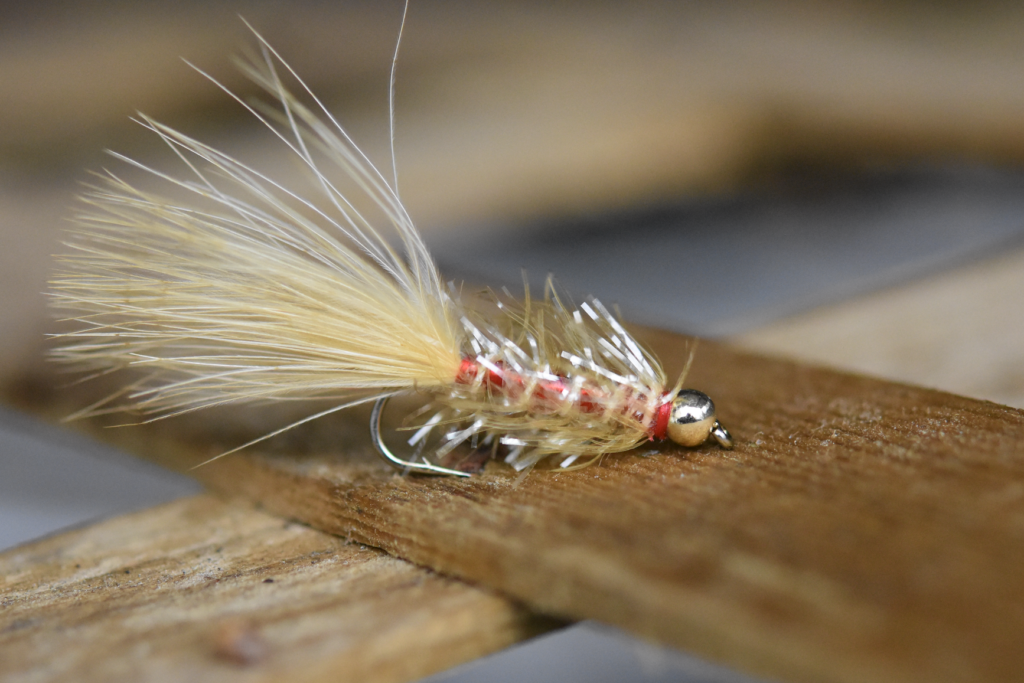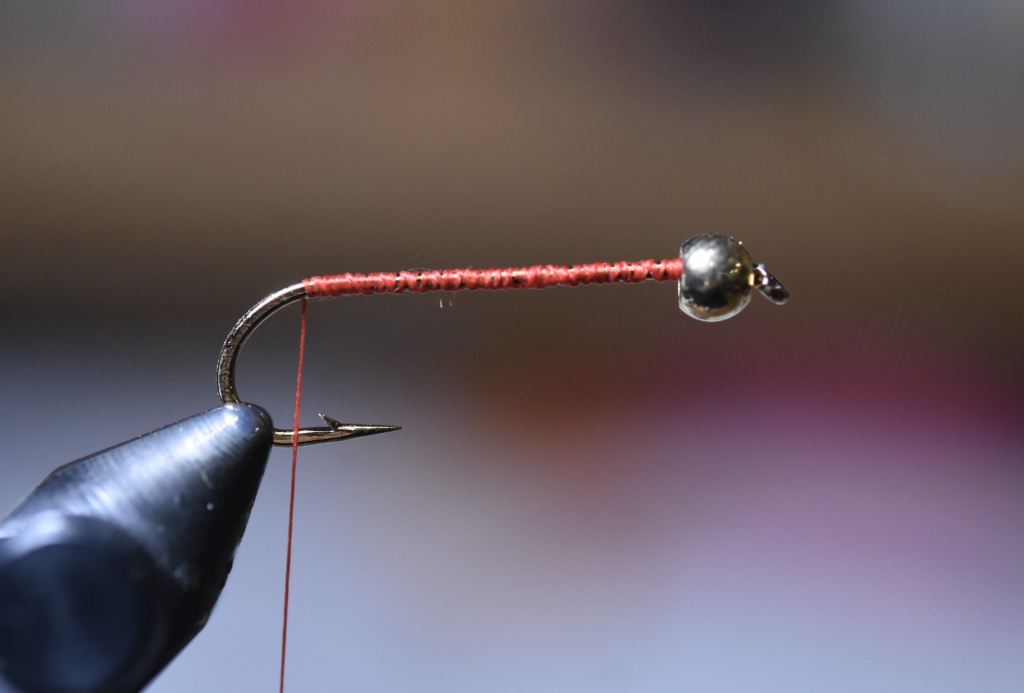Fishing and Tying the Golden Retriever Streamer

My introduction to the Golden Retriever came in a fly shop in Rangeley, Maine, in early June. A few friends and I had planned a trip to the “land of legends” in hopes of experiencing brook trout fishing the way it should be. And, of course, every good trip starts with a stop by the local fly shop, and there in the fly bin were various sizes of this unique streamer.
I’d heard about the Golden Retriever before but had never seen one in person. They’re remarkably simple, basically consisting of five materials: hook, bead, thread, marabou, and Estaz. I bought a handful in sizes 6, 8, and 10 to add to my collection of flies. I never thought I’d actually use them.
But I did use them. In fact, I used all of them, and of the half dozen purchased, one lone survivor remains, and I used it as an example to replenish my stock of Golden Retrievers.
Fishing the Golden Retriever
On that particular trip to Maine, I used the Golden Retriever pretty much as its name implies: I retrieved it. Short, slow strips were the ticket on the Kennebago River one evening for what ended up being my biggest Landlocked Salmon landed…not hooked…landed. This one was around 20 inches, but I lost a much longer and fatter Landlocked Salmon the next day, also on the Golden Retriever. Conditions were tough to start the trip, mainly due to high water, but the Golden Retriever produced.
I had the most success casting slightly quartering downstream and stripping it in very slowly through slower stretches of the Kennebago. On the much faster Magalloway River, I floated the streamer through pocket water, landing several good-sized brookies and missing one that can only be described as giant. A few weeks later, back home in Pennsylvania, I tied on a Golden Retriever one morning and landed several smallmouth bass and a handful of stocked trout. This fly flat-out catches fish!
Recently, I picked up a copy of Bob Mallard’s book, Favorite Flies for Maine: 50 Essential Patterns from Local Experts. Of course, one of the patterns Mallard writes about is the Golden Retriever. He writes: “The Golden Retriever is a small Bugger-like streamer. It is unique and effective, but simple with only three primary materials. The Estaz gives it a full-body look, and the red looks like gills or blood. While it looks like a minnow, I believe it can also be mistaken for a tumbling stonefly nymph or crayfish.”
Origins of the Golden Retriever
The Golden Retriever was designed by Jim Finn, a Virginia fly shop owner and guide. The fly proved itself on Mossy Creek, a local limestone stream with ultra clear water that is also choked with vegetation. As is the case with many similar streams (think Letort Spring Run!), the fish living there can test one’s skills and mental fortitude. I personally believe that any fly that catches a Letort Spring Run brown trout will likely catch fish anywhere in the country, so it makes sense that if the Golden Retriever fooled those Mossy Creek trout, then it would surely work everywhere, too. And it has.
In his book, Mallard also writes: “As is often the case in Maine, what is old is new, and things have a way of taking a bit longer to get here than they do other states. The Golden Retriever is an example, and regardless of the delay in getting here, many Maine fly fishers consider it to have been well worth the wait.”
I know at least one Pennsylvania angler who’s glad to have finally discovered the Golden Retriever, too.
Tying the Golden Retriever

If you’ve ever tied a Woolly Bugger, you’ll find the Golden Retriever a breeze to tackle. As with Buggers, use a long-shanked, 3XL-4XL streamer hook. The Model 24 down eye streamer hook from Wholesale Fly Company is a great choice for this pattern.
In Maine, I purchased these flies in sizes 6, 8, and 10 and caught fish on all three sizes. But I’m sure, as with Buggers, you could tie the Golden Retriever much smaller to imitate those stoneflies Mallard mentions in his book.
You can use a brass or tungsten bead on this fly, depending on how you intend to use it. I suppose you could even use a tungsten conehead if you want to make it even heavier to sink quicker in fast water. Generally speaking, I use 5/32 beads on size 8, and 9/64 on size 10. Bigger beads of bigger flies, and smaller beads on smaller flies.
Using red 6/0 thread (Semperfli Classic Waxed Thread is my first choice), lay down a good thread base. This will prevent the slippery marabou from sliding up and down the hook once the fly is finished. Next, tie in a length of marabou for the tail. The tail should be approximately 1-1.5 times the length of the hook shank. Also, a note about color here. I have gold, ginger, and tan marabou here. Although the pattern calls for gold-colored marabou, the ginger or tan more closely matches the patterns I purchased in Maine as well as photos I’ve seen of this fly in books and online. Also, ginger does a better job of matching what is considered gold-colored Estaz.

Next, tie in a length of gold Estaz and then create a smooth, even body with the red thread. It doesn’t have to be perfect, but the smoother you can make it, the more visually appealing the fly will look when finished.
Next, wrap the Estaz over the thread body in open spiral wraps and secure behind the bead. Make sure to leave some space between wraps so that the red thread shows through — this is part of why this pattern is so effective! Trim the Estaz and make a few extra wraps of red thread to create a noticeable collar. Whip finish and done!
The only “tricky” part of tying this fly is figuring out whether to make clockwise or counter-clockwise wraps with the Estaz. The material will have a natural curve to it, and I like that curve to flow toward the bend of the hook.


Did You Find This Fly Tying Guide Helpful?
Stay up to date with the Dark Skies Fly Fishing monthly newsletter for free and receive the latest posts in fly fishing news, tricks, tips, and techniques, stream reports, as well as updates on new flies added to the Online Store and exclusive discounts!
Sign Up NowHave a fly fishing question you’d like answered? Drop us a line at info@darkskskiesflyfishing.com! If we use your question in a blog post or in the newsletter, we’ll send you a FREE fly box with a dozen of our favorite nymphs and dry flies!


